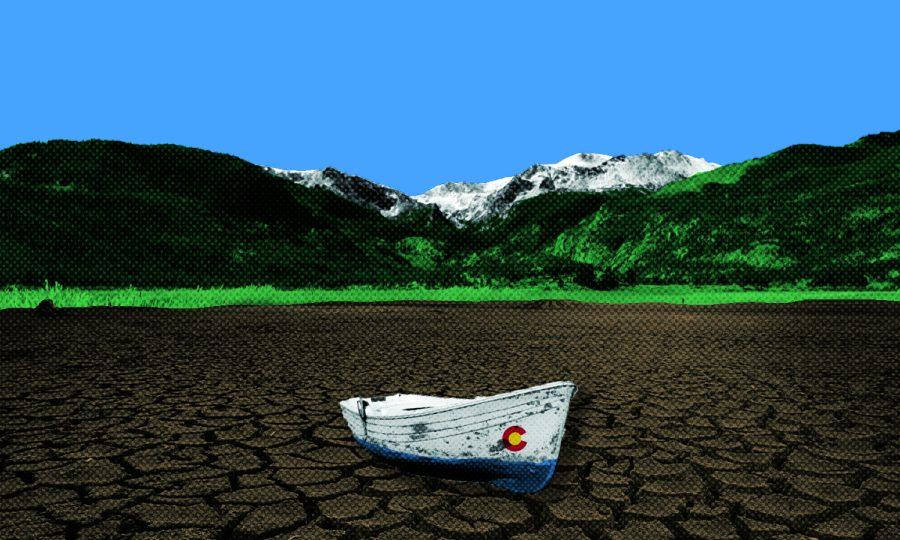Concerns about water rise as Colorado River negotiations continue
September 8, 2022
Dry, hot air settles over a small suburb in Fort Collins. The heat pushes residents indoors to crank the air conditioning, and the constant spurt of sprinklers is the only sound breaking the midday silence.
This is a common occurrence of exceptional waste that may need to become a scene that only exists in memory, especially for states like Colorado.
Colorado has been experiencing drought conditions on and off for decades. And combating the issue of water scarcity in the region has been a priority for the states that rely on Colorado’s water resources.
“As a headwater state, we’re a really critical location in terms of the different rivers that originate in Colorado,” said Melinda Laituri, professor emeritus in ecosystem science and sustainability at Colorado State University.
One of these rivers is the Colorado River, the sixth-longest river in the country, which serves nearly 40 million people. It’s a critical resource for the Southwest United States and Mexico.
“The lower basin and the southern half of the upper basin had been in drought for 22 years,” said Steven Fassnacht, a snow hydrologist and professor at CSU.
The Colorado River Compact of 1922 has been a focus, as the rights established in the compact are being renegotiated to protect the river.
A lot of this water access is dependent on snowpack. From the flow of the Colorado River to ground water resources, snow is integral to water access, and Colorado is simply not getting the amount it used to.
“From the mid ’30s to the mid ’70s, the snowpack was actually increasing,” Fassnacht said. “And since then, the trend has been a decrease in the snowpack.”
This is particularly concerning when resources are used to manufacture snow for skiing or water lawns that aren’t beneficial to local ecosystems. The larger ecological impacts Colorado has been facing, like fires and excess use of resources, have to be considered.
“If you burn the hillside, then you really increase the likelihood that you’re going to have rainfall causing erosion,” Fassnacht said. “You’ve got a lot of sediment that ends up in the river. Ash is terrible for the water treatment plants.”
Think of what it would mean to have ash in your drinking water or even just damaging water treatment facilities. This reality means the way we interact with water may have to drastically change in order to protect it.
“We have the expectation that we can go to the tap and turn it on and water will be there,” Laituri said.
Even using your sprinklers in the middle of the day or overusing natural resources by running your AC all of the time can have serious impacts on water resources and the ecosystems they serve.
“It comes down to education too because not everyone is a watershed scientist,” said Eric Williams, president of the Watershed Science Club at Colorado State University.
Williams said lawns and developers should concern the public in regard to water use.
“I think if we want to point the finger at something, it should be all of these lawns that we have,” Fassnacht said. “I’m not saying let’s get rid of every last piece of lawn, but let’s be a lot more strategic.”
This is not a new idea. Nevada has begun to remove lawns, and the City of Fort Collins has an initiative to encourage xeriscaping, the replacement of lawn with local plants that fare better in drought conditions.
Participating in these programs and educating yourself, Williams said, are some of the best ways to get involved. However, the average citizen can’t simply stop watering their lawn and expect the drought to no longer exist.
“I don’t know if this can be really driven at the individual level,” Laituri said. “Yes, it makes us feel good to do things that we feel are contributing. … Will that be enough? It’s the larger water users that are going to have to really come to the table.”
We cannot continue to live in a world wherein wealthy citizens and major celebrities can abuse their water allocations while others go without access to clean water at all. The issue of water scarcity is an elaborate entanglement of social justice and environmental concern, meaning the resource must first be treated like a necessity before it can be allocated for luxury.
“There’s 30 federally recognized (Indigenous) tribes across the lower basin that should have access to water, and many other reservations actually don’t have running water,” Laituri said. “Assuring that they have access to that resource is part of this conversation.”
Indigenous groups were not included in the Colorado River Compact, and as some of the most prominent advocates of water rights, they have a lot to contribute to the conversation.
Indigenous groups are not the only population to be considered as water rights are negotiated. Laituri emphasized new populations coming to Fort Collins should be considered.
Laituri said if we want to conserve water, we need to consider the state’s capacity when developing. We need to consider if we can house more people and if it’s responsible to continue this growth in population.
While the concerns around the river are complex and still not fully understood, that doesn’t mean action isn’t being taken. And it doesn’t mean there aren’t any solutions.
“Please be curious,” Williams said. “No question is (a) dumb question.”
Reach Ivy Secrest at life@collegian.com or on Twitter @IvySecrest.








